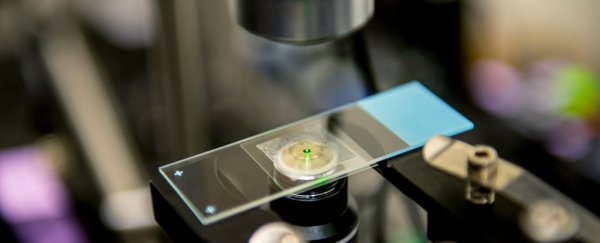Whether it's James Bond strapped to a table, Han Solo being cornered by Greedo in the Mos Eisley Cantina, or any other movie scene where lasers are being used as a weapon, the implication is that they do their damage by focusing intense heat on their target.
And so it was in the real world (albeit with less melodrama). Until now, that is. For the first time, scientists have used a laser to cool things down, by figuring out how to make a laser refrigerate water and other types of liquid.
"Typically, when you go to the movies and see Star Wars laser blasters, they heat things up. This is the first example of a laser beam that will refrigerate liquids like water under everyday conditions," said Peter Pauzauskie, a researcher in materials science and engineering at the University of Washington. "It was really an open question as to whether this could be done because normally water warms when illuminated."
Pauzauskie and his team used an infrared laser to cool water by about 20 degrees Celsius (36 degrees Fahrenheit). Describing their method in the journal PNAS, the team says they effectively ran a laser in reverse, illuminating a microscopic crystal suspended in water so that it glowed with slightly more energy than the amount of light absorbed.
The effect of this higher-energy glow (which you can see at work in the image above) is that it actually carries heat away from the crystal and the water around it. The technique had been demonstrated in a vacuum by researchers at the Los Alamos National Laboratory some 20 years ago, but never achieved with liquids until now.
If the system can be refined and made more efficient – it's currently very energy-intensive – the applications for refrigerating lasers could be huge. The researchers say they could theoretically cool any tiny areas with a focussed point of light – perhaps one day even refrigerating and slowing down biological processes for scientific study.
"There's a lot of interest in how cells divide and how molecules and enzymes function, and it's never been possible before to refrigerate them to study their properties," said Pauzauskie. "Using laser cooling, it may be possible to prepare slow-motion movies of life in action. And the advantage is that you don't have to cool the entire cell, which could kill it or change its behaviour."
Another area of great potential is technology: we could use lasers to cool microprocessors inside computers, or any other components that build up a high amount of heat and threaten both performance and the life of the hardware.
But even that's just scratching the surface. Since this has never been done before, it may take a while for scientists to come up with the best ways of using lasers that do the opposite of heating things up.
"Few people have thought about how they could use this technology to solve problems because using lasers to refrigerate liquids hasn't been possible before," Pauzauskie said. "We are interested in the ideas other scientists or businesses might have for how this might impact their basic research or bottom line."
